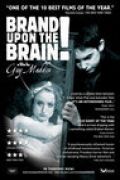
Directed by
Guy Maddin
95 minutes
Rated R
Reviewed by
David Michael Brown

Brand Upon The Brain
Synopsis: Guy Maddin (Erik Steffen Maars), a man haunted by his childhood, returns to Black Notch Island at the behest of his dying mother. Her final wish is for her son to paint the lighthouse and orphanage in which they used to live. As he paints he begins to have flashbacks to his early years. Back then his father spent his entire time in a basement laboratory experimenting on the orphanage’s patrons. The children all have strange scars on the backs of their heads and walk around like zombies. The young Guy (Sullivan Brown) joins forces with his sister, Sis (Maya Lawson) and a young female sleuth, Wendy Hale (Katherine Scharhon), to try and discover the secret of his father’s experiments and find out why their mother appears to be getting younger.
Anyone not familiar with the films of Canadian Guy Maddin’s films will be in for a shock. They will probably start to get nervous when they realise that Brand Upon the Brain! is meant to be autobiographical. If you haven’t seen his willfully absurd, Grand Guignol silent films like Dracula: Notes from A Virgin’s Diary (2002) you will have no idea how this idiosyncratic director’s mind works. Saying that, the moment you discover that Maddin’s parents have been harvesting nectar from the brains of the orphans in their charge, you know that this film has taken a surreal turn.
Maddin’s use of black and white photography is extraordinary. The flashes of colour and the use of grainy stock dazzle the eye. Moments like the mother sitting at the top of the lighthouse using the light to stalk her children who she knows are up to no good are fabulous. The music is opulent and grandiose; Maddin’s films constantly astound with their combination of music and visuals and Brand Upon the Brain! does not disappoint with its score by Jason Staczek. The often grating and distorted sounds of the communication system that Guy’s mother uses to contact her children recall the soundscapes of David Lynch’s Eraserhead (1978). It’s no surprise to discover that the film is designed to be shown with a live orchestra, narrator and Foley artists but even in the conventional theatrical presentation this film still works wonders.
Performance-wise, the actors take their cues from the movies of old. Without any dialogue, over the top portrayals are de rigueur. Constant eye rolling and abundant grimaces take the place of emotions. Using all of the trappings of the old silent film era, combined with a marvelously over the top narration by Isabella Rossellini, the star of the filmmaker’s previous effort, The Saddest Music in the World (2003). The film takes great delight in ridiculing the sometimes awful occurrences on screen, using the narration and title cards with perfect timing. Child abuse, lesbianism, mild cannibalism and strange mind-altering experiments are all part of Maddin’s bizarre concoction. “He replaced his cremated father with a hamster and a metronome” has to be my favorite title card but you will have to watch the film to discover what part burnt parents and tiny mammals play in Maddin’s delirious life story. This a bravura piece of film-making that will bemuse most but if you can be enticed to enter Maddin’s bizarre world you are in for a treat.

Want more about this film?


Want something different?




